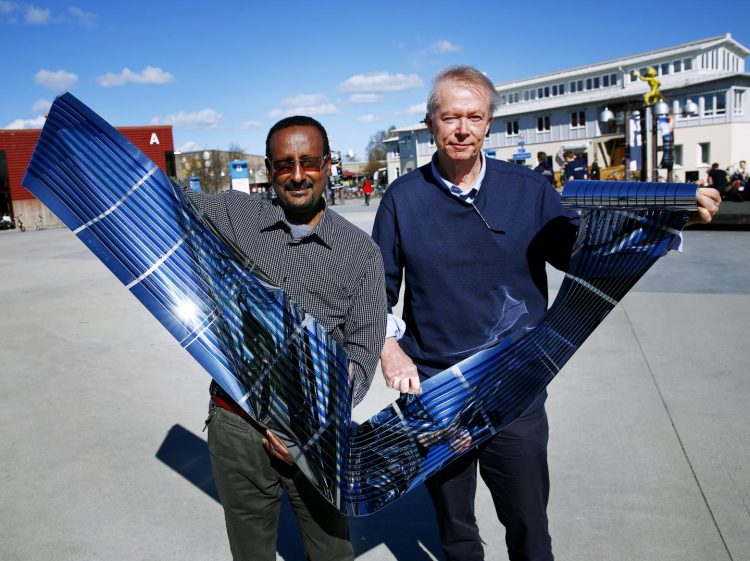New world record for fullerene-free polymer solar cells

Polymer solar cells manufactured using low-cost roll-to-roll printing technology, demonstrated here by professors Olle Inganäs (right) and Shimelis Admassie. Credit: Stefan Jerrevång/Linkoping university
Polymer solar cells can be even cheaper and more reliable thanks to a breakthrough by scientists at Linköping University and the Chinese Academy of Sciences (CAS). This work is about avoiding costly and unstable fullerenes.
Polymer solar cells have in recent years emerged as a low cost alternative to silicon solar cells. In order to obtain high efficiency, fullerenes are usually required in polymer solar cells to separate charge carriers. However, fullerenes are unstable under illumination, and form large crystals at high temperatures.
Now, a team of chemists led by Professor Jianhui Hou at the CAS set a new world record for fullerene-free polymer solar cells by developing a unique combination of a polymer called PBDB-T and a small molecule called ITIC. With this combination, the sun's energy is converted with an efficiency of 11%, a value that strikes most solar cells with fullerenes, and all without fullerenes.
Feng Gao, together with his colleagues Olle Inganäs and Deping Qian at Linköping University, have characterized the loss spectroscopy of photovoltage (Voc), a key figure for solar cells, and proposed approaches to further improving the device performance.
The two research groups are now presenting their results in the high-profile journal Advanced Materials.
-We have demonstrated that it is possible to achieve a high efficiency without using fullerene, and that such solar cells are also highly stable to heat. Because solar cells are working under constant solar radiation, good thermal stability is very important, said Feng Gao, a physicist at the Department of Physics, Chemistry and Biology, Linköping University.
-The combination of high efficiency and good thermal stability suggest that polymer solar cells, which can be easily manufactured using low-cost roll-to-roll printing technology, now come a step closer to commercialization, said Feng Gao.
###
Article: Fullerene-free polymer solar cells with over 11% efficiency and excellent thermal stability, by Wenchao Zhao, Deping Qian, Shaoqing Zhang, Sunsun Li, Olle Inganäs, Feng Gao and Jianhui Hou. Advanced Materials 2016. DOI: 10.1002/adma.201600281
Media Contact
All latest news from the category: Materials Sciences
Materials management deals with the research, development, manufacturing and processing of raw and industrial materials. Key aspects here are biological and medical issues, which play an increasingly important role in this field.
innovations-report offers in-depth articles related to the development and application of materials and the structure and properties of new materials.
Newest articles

Superradiant atoms could push the boundaries of how precisely time can be measured
Superradiant atoms can help us measure time more precisely than ever. In a new study, researchers from the University of Copenhagen present a new method for measuring the time interval,…

Ion thermoelectric conversion devices for near room temperature
The electrode sheet of the thermoelectric device consists of ionic hydrogel, which is sandwiched between the electrodes to form, and the Prussian blue on the electrode undergoes a redox reaction…

Zap Energy achieves 37-million-degree temperatures in a compact device
New publication reports record electron temperatures for a small-scale, sheared-flow-stabilized Z-pinch fusion device. In the nine decades since humans first produced fusion reactions, only a few fusion technologies have demonstrated…





















